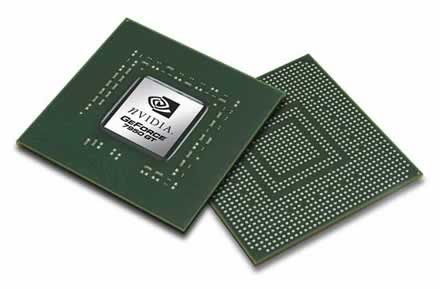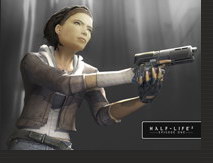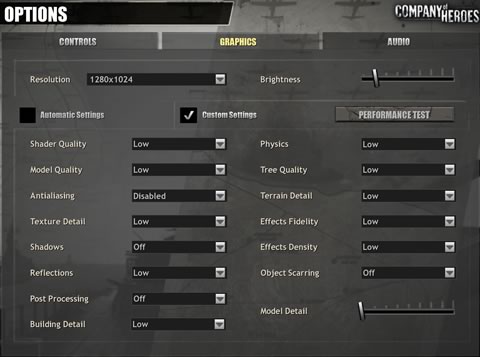1. Introduction
 XFX recently announced a new series of VGA cards aimed at enthusiast users, based on Nvidia's 7950GT series. The board design is unique and comes with passive cooling, offering the best possible performance, combined with zero noise level. We compared the XFX 7950GT against various other cards, with the latest released games.
XFX recently announced a new series of VGA cards aimed at enthusiast users, based on Nvidia's 7950GT series. The board design is unique and comes with passive cooling, offering the best possible performance, combined with zero noise level. We compared the XFX 7950GT against various other cards, with the latest released games.
- XFX 7950GT
XFX uses the reference board design from Nvidia's 7950GT series. Below, you can find a comparison between the various GeForce 7 series models, depicting the main differences in specs, since we will be comparing them in real life gaming tests.

GeForce 7 Series GPUs Model Comparison
Feature |
GeForce 7950 Models |
GeForce 7900 Models |
GeForce 7800 Models |
GeForce 7600 Models |
GeForce 7300 Models |
Graphics Bus Technology |
PCI Express |
PCI Express |
AGP 8X/PCI Express |
AGP 8X/PCI Express |
PCI Express |
Microsoft® DirectX® 9.0 |
SM3.0 |
SM3.0 |
SM3.0 |
SM3.0 |
SM3.0 |
NVIDIA® Intellisample™ Technology |
4.0 |
4.0 |
4.0 |
4.0 |
4.0 |
NVIDIA® SLI™ Technology |
Y |
Y |
Y |
Y |
Y |
High Dynamic-Range (HDR) Support |
Y |
Y |
Y |
Y |
Y |
NVIDIA® TurboCache™ Technology |
n/a |
n/a |
n/a |
n/a |
Y |
Effective Memory Interface |
512-bit |
256-bit |
256-bit |
128-bit |
128-bit3/64-bit |
Memory |
GDDR3 |
GDDR3 |
GDDR3 |
GDDR3/DDR2 |
GDDR3/DDR2 |
Process |
0.09 µ |
0.09 µ |
0.11 µ |
0.09 µ |
0.09 µ |
RAMDACs |
400MHz |
400MHz |
400MHz |
400MHz |
400MHz |
.jpg) Geforce 7900 series Chipset Features
Geforce 7900 series Chipset Features
Next Generation Super Scaler GPU Architecture
Delivers over 2x the shading power of previous generation products, taking gaming performance to extreme levels.
Full Microsoft® DirectX® 9.0 Shader Model 3.0 Support
The standard for today's PCs and next generation consoles enables stunning and complex effects for cinematic realism.
NVIDIA® CineFX® 4.0 Engine
Delivers advanced visual effects at unimaginable speeds. Next generation shader architecture with new texture unit design streamlines texture processing for faster and smoother gameplay.
 NVIDIA® SLI Technology
NVIDIA® SLI Technology
NVIDIA SLI technology is a revolutionary platform innovation that allows users to intelligently scale graphics performance by combining multiple NVIDIA graphics solutions in a single system with an NVIDIA nForce SLI MCP.
NVIDIA® Intellisample 4.0 Technology
The industry’s fastest antialiasing delivers ultra-realistic visuals with no jagged edges, at lightning-fast speeds. Visual quality is taken to new heights through a new rotated grid sampling pattern, advanced 128 tap sample coverage, 16x anisotropic filtering, and support for transparent supersampling and multisampling.
True High Dynamic-Range (HDR) Rendering Support
The ultimate lighting effects bring environments to life for a truly immersive, ultra-realistic experience. NVIDIA's 64-bit texture implementation delivers state-of-the-art high dynamic-range (HDR) visual effect through floating point capabilities in shading, filtering, texturing and blending.

NVIDIA® PureVideo Technology
The combination of high-definition video processors and decoder software delivers unprecedented picture clarity, smooth video, accurate color and precise image scaling for all video content to turn your PC into a high end home theater.
NVIDIA® UltraShadow II Technology
Enhances the performance of bleeding-edge games that feature complex scenes with multiple light sources and objects.
NVIDIA® ForceWare® unified Driver Architecture (UDA)
Delivers a proven record of compatibility, reliability and stability with the widest range of games and applications. ForceWare ensures the best out-of-box experience for every user and delivers continuous performance and feature updates over the life of NVIDIA GeForce GPUs.
OpenGL® 2.0 Optimizations and Support
Ensures top-notch compatibility and performance for Open GL applications.
NVIDIA® nView Multi-Display Technology
Advanced technology provides the ultimate in viewing flexible and control for multiple monitors.
PCI Express® Support
Designed to run perfectly with the next generation PCI Express bus architecture. The new bus doubles the bandwidth of AGP 8X delivering over 4 GB/sec. in both upstream and downstream data transfers.
Before buying such a high end card, users should note the system requirements:
1. Microsoft Windows® 2000/XP
2. A PCI-Express compliant motherboard with full size ex pension slot
3. Installation requires CD-ROM or DVD-Rom drive
4. A 6-pin PCI Express supplementary power connector
5. DVI or VGA compatible monitor
6. Minimum of 500-600W Power Supply with a minimum of +12V @ 30A for all PC components in SLI mode
2. Retail package
XFX sent us the retail version of the XFX GeForce 7950GTS with the codename PV-T71J-YHF9.

At the same time, XFX offers three other variations of the 7950GT series with different core/memory timings and with SLI, Dual DVI Out , and HDTV (HDCP) support:
Model |
Core |
Memory |
Other features |
PV-T71J-YHD9 |
610 MHz |
1.6 GHz |
TV Capture |
PV-T71J-YHE9 |
570 MHz |
1.5 GHz |
TV Out |
PV-T71J-YPE7 |
570 MHz |
1.46 GHz |
- |
PV-T71J-YHF9 |
550 MHz |
1.4 GHz |
TV Out |
PV-T71J-YPF7 |
550 MHz |
1.4 GHz |
- |
The PV-T71J-YHF9 model can be found at the retail price of US$300~$350. Prices may vary depending on your region. The retail box has the usual impressive XFX design:


XFX has included with the card, the retail version of Ghost Recon Advanced Warfighter!


While all required cables/connectors are also included:

To sum it up, the retail package includes:
- A 7950GT card
- A printed users manual in 13 languages
- A printed quick installation guide
- 2x DVI-DSub15 Dongles
- A S-Video to Composite Cable
- Software CD with drivers
- Retail version of Ghost Recon Advanced WarFighter
Looking at the card, it's a standard sized graphics card, so it should fit in your mid ATX case without too many problems . Despite the passive cooling, the overall size/weight ratio is good:

The card needs a PCI-E power supply installed in order to operate properly. Remember, you need at least a 600W SLI certified PSU if you decide to go SLI.

The card has two DVI-D outputs and one S-Video output.

On the rear of the PCB, we can see the passive cooling fins:


The memory is clocked at 770MHz, while the GPU at 550MHz. The XFX 7950GT uses Infineon memory modules (DDR3) with a total memory capacity of 512MB RAM. The G71GT core is shown below.


Everest Ultimate Edition 2006 gave us some details on the G71GT core:

3. Tests
Our PC setup was as follows:
- Foxconn C51XEM2AA (Intel 590SLI) + AMD Athlon X2 4600+
- Thermaltake Soprano Case
- OCZ GameXStream GXS600 SLI-Ready
- 2x1GB OCZ DDR2-6400 SLI Ready
- WD 800JB 7200RPM
- Viewsonic 19" LCD VP930b (1280x1024 resolution)
- Windows XP SP2 with all latest updates installed
- nVidia Forceware v92.91 (beta) with the following settings

While for benchmarking, we used:
- 3D Mark 05 v1.2.0
- 3D Mark 06 v1.2.0
- F.E.A.R v1.06
- Prey v1.01
- Half Life 2 Episode 1 June Edition
- Splinter Cell - Chaos Theory v1.05
- Battlefield 2142 v1.00
- Company Of Heroes v1.2.0
- 3D Mark 05 v1.2.0


3D Mark 05 is a well know benchmark utility that represents the combination of CPU+VGA strength. The XFX 7950GT was faster than the 7900GS cards, as was expected, reaching 8183 3D Mark 05 points.
- 3D Mark 06 v1.2.0


Passing on to 3D Mark 06, the FXF 7950GT showed good performance with 5242 points.
4. F.E.A.R
 The story begins as an unidentified paramilitary force infiltrates a multi-billion dollar aerospace compound. The government responds by sending in Special Forces, but loses contact as an eerie signal interrupts radio communications. When the interference subsides moments later, the team has been literally torn apart. As part of a classified strike team created to deal with threats no one else can handle, your mission is simple: Eliminate the intruders at any cost. Determine the origin of the signal. And contain this crisis before it spirals out of control.
The story begins as an unidentified paramilitary force infiltrates a multi-billion dollar aerospace compound. The government responds by sending in Special Forces, but loses contact as an eerie signal interrupts radio communications. When the interference subsides moments later, the team has been literally torn apart. As part of a classified strike team created to deal with threats no one else can handle, your mission is simple: Eliminate the intruders at any cost. Determine the origin of the signal. And contain this crisis before it spirals out of control.
The game offers up to 1280x960 resolution, which used for all tests. We maxed all details for CPU and for the VGA card, except Soft Shadows and AA/AF. Using Forceware 3D Control panel, we enabled AA/AF as indicated in each graph. Below are the results after using the built-in benchmark test:

At 1280x960 without any AA/AF, the 7950GT was faster by 17FPS (average) and didn't drop below 43 FPS.

Enabling AA and AF creates a performance drop with all VGA cards. The XFX 7950GT has an almost linear decrease in framerate, while with 16x AF and 8xS AA enabled, it managed 38FPS (average).
5. Prey
 Prey tells the story of Tommy, a Cherokee garage mechanic stuck on a reservation going nowhere. His life changes when an otherworldly crisis forces him to awaken spiritual powers from his long-forgotten birthright. Abducted along with his people to a menacing mothership orbiting Earth, he sets out to save himself and his girlfriend and eventually his planet.
Prey tells the story of Tommy, a Cherokee garage mechanic stuck on a reservation going nowhere. His life changes when an otherworldly crisis forces him to awaken spiritual powers from his long-forgotten birthright. Abducted along with his people to a menacing mothership orbiting Earth, he sets out to save himself and his girlfriend and eventually his planet.
Prey is serious, dark story, based on authentic Cherokee mythology. Themes of sacrifice, love and responsibility are explored and the story dives into emotional territory not yet explored by similar games. Prey is based on Quake 3 engine and for sure will keep you awake many nights...
For all tests, we used hocbench that offers all benchmarking options via a GUI. We used the built-in Guru3D timedemo and all results are posted below:

Without enabling AA/AF, the XFX 7950GT scored 79.7 FPS, around 8 FPS faster than the 7900GS. After enabling Anti-aliasing and Anisotropic filtering, performance drops. With 16x AF / 4x AA, the XFX 7950GT was around 50FPS, making it the best choice in this comparison. With maximum quality (16xAF/8xS AA), performance was still good, at 35FPS.

It appears our SLI setup didn't perform as well as expected, reporting low framerates after enabling AA/AF...
6. Splinter Cell Chaos Theory
A Japanese Information Defense Force is formed to help face modern threats. Deemed a violation of international law and of the Japanese Post-War Constitution, Korea and China become outraged.
 Secretly, the head of the IDF begins launching information-warfare attacks against Japan and blaming the attacks on North Korea. When the U.S. intervenes, as they are obligated to under Article 9 of the Japanese Post-War Constitution, the U.S. is attacked as well, forcing North Korea to escalate the situation with a pre-emptive invasion of South Korea.
Secretly, the head of the IDF begins launching information-warfare attacks against Japan and blaming the attacks on North Korea. When the U.S. intervenes, as they are obligated to under Article 9 of the Japanese Post-War Constitution, the U.S. is attacked as well, forcing North Korea to escalate the situation with a pre-emptive invasion of South Korea.
As war erupts on the Korean Peninsula, Sam Fisher must thwart the alliance between the Japanese Admiral, a neurotic computer hacker, and the head of an international paramilitary company in order to prevent the rekindling of a massive world war in the Pacific.
The graphics engine supports Pixel Shader 1 and 3, HDR along with other new effects. We used hocbench that offers all benchmarking options through an easy GUI.

We used the built-in "Guru3D 2" timedemo and all results are posted below, using SM1.1

The performance difference between the 7900GS and 7950GT was 23.64FPS.

Enabling SM 3.0, gives a performance drop of 17.47 FPS, dropping the average framerate down to 59.17. The 7900GS cards suffer a lower performance hit of just 10FPS.


Lastly, after enabling the various AA and AF modes, we can see the performance differences between the various cards. At the maximum possible quality, a framerate of 40FPS for the XFX7950GT was very good.
7. Half Life 2 Episode 1
The world of Half-Life 2 has amazed everyone with its great story, graphics and Valve's great support. Half-Life 2: Episode One is the first in a series of new adventures created by Valve that extend the Half-Life 2 single player experience. It details the aftermath of Half Life 2 and launches a journey beyond City 17.
 Stepping into the hazard suit of Dr. Gordon Freeman, you face the immediate repercussions of your actions in City 17 and the Citadel. Rejoin Alyx Vance and her robot, Dog, to once again aid the human resistance in their desperate battle against the totalitarian alien menace of the Combine.
Stepping into the hazard suit of Dr. Gordon Freeman, you face the immediate repercussions of your actions in City 17 and the Citadel. Rejoin Alyx Vance and her robot, Dog, to once again aid the human resistance in their desperate battle against the totalitarian alien menace of the Combine.
Episode One exposes Alyx's combat skills and knowledge of City 17. Battle side-by-side with her through Valve's first episodic game, a four-to-six hour adventure of greater density and detail than non-episodic releases.
We recorded a timedemo and used the console to run each card with different visual quality settings. For all tests, we set 1280x1024 with HDR shadows fully enabled.


At 1280x1024, the XFX 7950GT had the highest performance at 116.18 FPS. The performance difference between it and the 7900GS series is 31.38%.

Enabling AA/AF with HDR does have an effect on performance. With the highest possible visual quality settings, the 7950GT keeps above 50FPS average, making it an ideal solution for all HL2 fans.
8. Company Of Heroes
 In Company of Heroes, gamers will experience the journey of the brave men of Able Company in a deep single-player campaign that begins with the invasion of Normandy through their fight across Europe, all set against the most dynamic battlefield ever seen in a game.
In Company of Heroes, gamers will experience the journey of the brave men of Able Company in a deep single-player campaign that begins with the invasion of Normandy through their fight across Europe, all set against the most dynamic battlefield ever seen in a game.
Company of Heroes' completely destructable environment means no two battles ever play out in the same way. Advanced squad AI delivers startling new realism and responsiveness, bringing soldiers to life as they interact with the environment and execute advanced squad tactics to eliminate the opposition forces.

The game offers impressive graphics. We used the built-in benchmark for all tests. Due to various performance visual settings, we chose four quality modes (Ultra, High, Medium, Low) at 1280x1024 resolution. Each quality mode setting is posted above each graph for your reference.
- Ultra Mode

In this mode, all quality settings are at maximum and Antialising is enabled. This is the worst case scenario for your card but if it can handle it, it offers the best visual effects.
- High Mode

In this mode, all quality settings are at maximum except for Antialising which is disabled.
- Medium Mode

In this mode, most quality settings are set to medium, while others are disabled altogether.
- Low Mode

In this mode, most quality settings are set to low, and others are disabled.
After having seen the settings we used for our tests, let's see how each card performed in the Company Of Heroes Benchmark with Ultra Quality settings.

Strangely, the 7950GT and 7900GS cards performed exactly the same, at least in the average framerate. The 7950GT had a higher minimum framerate (15 vs 11.8) but we cannot understand why the average performance was at the same levels.

Passing from Ultra to High (anti-aliasing disabled), does give somewhat higher FPS, but not too much. What is rather interesting is that even our 7900GS SLI doesn't offer much higher performance, as we would expect. Disabling several visual improvements, give much higher framerates, with the 7900SLI setup really taking off. With all visual settings, the 7950GT had lower performance than the 7900GS, which is a little puzzling...
9. BattleField 2142
 The year is 2142, and the dawn of a new Ice age has thrown the world into a panic. The math is simple and brutal: The soil not covered by ice can only feed a fraction of the Earth's population. Some will live, most will die. In Battlefield 2142, players will choose to fight for one of two military superpowers in an epic battle for survival, the European Union or the newly formed Pan Asian Coalition.
The year is 2142, and the dawn of a new Ice age has thrown the world into a panic. The math is simple and brutal: The soil not covered by ice can only feed a fraction of the Earth's population. Some will live, most will die. In Battlefield 2142, players will choose to fight for one of two military superpowers in an epic battle for survival, the European Union or the newly formed Pan Asian Coalition.
Armed with a devastating arsenal of hi-tech assault rifles, cloaking devices and sentry guns, players will also do battle using some of the most imposing vehicles known to man. Massive battle Mechs wage fierce combat on the ground, while futuristic aircraft rule the skies. When facing one of these new behemoths, players will need to use their wits and an arsenal of new countermeasures like EMP grenades to level the playing field.

Team play features allow up to 64 players to enter the action on the front lines as part of a formal squad, or work behind the scenes in Commander Mode to direct the strategic assaults of their teammates. With in-game success, players increase their rank and unlock awards, including new weapons, medals and more, delivering the most comprehensive and flexible persistence in the Battlefield universe to date.

In order to benchmark the graphic cards, we recorded our own timedemo using the built-in command (demo.recordDemo). Then we used Guru3D BF2 benchmark, modified in order to support BF 2142. We used the following quality settings. Anti-aliasing is disabled in the game, we used Forceware AA/AF to enable disable such rendering modes:

Since the game counts all frames, including loading screens, we removed them so that all numbers represent pure gaming experience. Note, that all tests were performed at 1280x1024 with default camera view.
Without enabling AA/AF, we can see the performance of each card at 1280x1024. The difference between the 7950GT and 7900GS is around 13.63FPS.

Enabling AA/AF affects the performance of each VGA card. The XFX 7950GT with 16x AF/ 8xS AA mode, produced 30FPS, making it playable.

10. Overclocking
As with most enthusiasts, we were very curious as to how well the XFX 7950GT, with its passive cooling, would overclock. With stock settings, the XFX 7950GT runs at 550MHz core and 700MHz memory clock:

Using coolbits registry "hack" we enabled the overclocking features on Nvidia's control panel. Next step was to start playing around, trial and error method, raising the frequency, running 3D Mark 06 to stress the the VGA card until we had a stable state. Our best trials reached 601MHz core and 804 MHz memory, a 9.27% (core) and 14.29% (memory) improvement:

Usually, overclocking does affect gaming experience, but we had to find out by how much exactly:



Looking at the results, the performance differences are not high (6.81% for 3DMark06, 2.38% for Prey and 11.07% for COH). Perhaps with an active cooling solution, we could get better overclocking... Lastly, the GPU runs hot enough when at idle, reaching 60°C, while at full load, tops 82°C.
11. Conclusion
 The XFX 7950GT is the latest offer from XFX for high performance gaming. The 7900 card series includes the latest technology from nVidia and promises unbeatable visual and gaming experience. XFX has chosen to provide only a silent 7950GT based card, that delivers zero noise. The card we tested was the PV-T71J-YHF9 model with 550MHz GPU and 700MHz memory clock. XFX offers four more cards from the same family with higher GPU/Memory clocks and slightly different options (TV out, TV capture). The card has a retail price of US$300~350.
The XFX 7950GT is the latest offer from XFX for high performance gaming. The 7900 card series includes the latest technology from nVidia and promises unbeatable visual and gaming experience. XFX has chosen to provide only a silent 7950GT based card, that delivers zero noise. The card we tested was the PV-T71J-YHF9 model with 550MHz GPU and 700MHz memory clock. XFX offers four more cards from the same family with higher GPU/Memory clocks and slightly different options (TV out, TV capture). The card has a retail price of US$300~350.

The overall design of the card is rather unique. The black metal finish with green DVI connectors and the XFX logo on the passive heatsink gives an impressive look. Despite using passive cooling, the overall volume and weight of the card is very good. The double DVI output is nowadays a standard. Additionally, HDCP is also supported so you can playback High Definition content (HD DVD, Blu-Ray) without any problems. The card is rated Vista Ready, another plus for futureproof buy.

Passing on to the card's performance, overall the card was faster than the 7900GS cards in most tests. There were two cases where the 7900GS and XFX 7950GT had almost identical performance. We believe that there was a problem with the drivers or that the particular games did not take advantage of the full capabilities of the card, since all our tests verified its superiority. Enabling AA/AF is no trouble for this card, being able to sustain high framerates in almost all games. We weren't able to get much of a boost in overclocking and this may be due to the passive cooling. The card is capable of supporting 1600x1200+ resolutions, but without AA/AF enabled in most cases. For such high resolutions and quality modes, you should add a second 7950GT card. After all, the XFX 7950GT is SLI ready :-)

Lastly, we have to comment on the large retail package for the XFX 7950GT. Not only is it very well designed and includes all needed cables and printed installation guide in 13 languages, but also the retail version of Ghost Recon Advanced Warfighter! A great addition from XFX for all hardcore gamers out there, "Play Hard!"

| Performance |
 |
| Overclocking |
 |
| Bundle |
 |
| Value for money |
 |